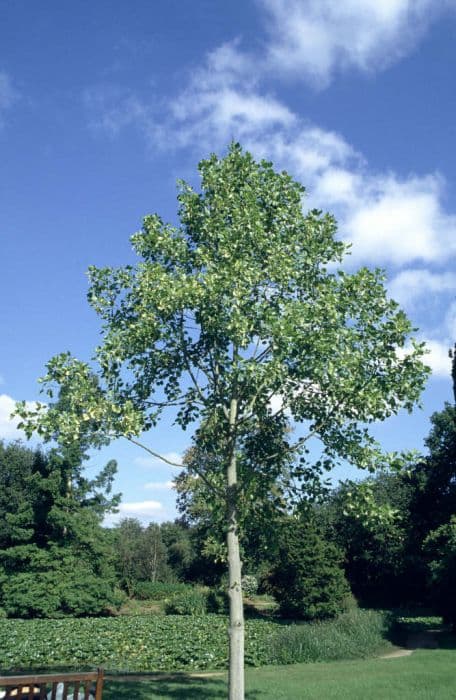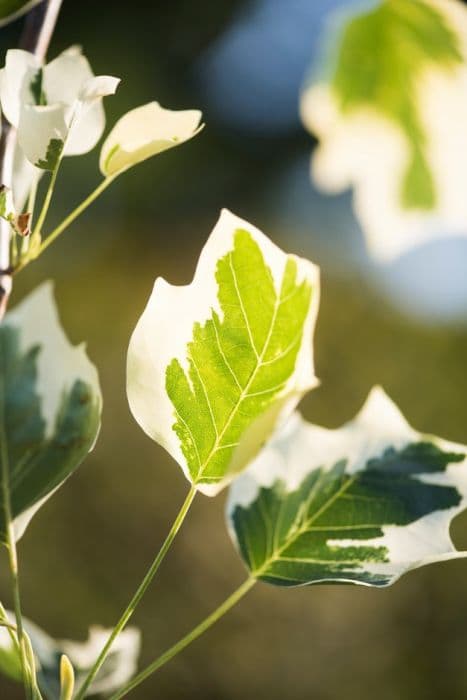Magnolia Magnolia 'Leda'

ABOUT
Magnolia 'Leda' is a captivating ornamental plant known for its striking large flowers, which are the hallmark of the magnolia family. The blooms exhibit an alluring creamy white hue that often features a flushed pink base, giving them a two-tone appearance that is both elegant and eye-catching. Each flower is composed of a number of broad, waxy petals that open from velvety buds, typically unfurling to reveal a voluptuous and almost sculptural cup or goblet shape. The foliage of Magnolia 'Leda' is equally attractive, with leaves that offer a lush backdrop to the impressive blossoms. These leaves are generally glossy and vibrant green, sometimes with a hint of brownish or coppery coloration on the undersides. The leaves are elongated and pointed at the tips, creating a contrast in texture and form with the soft, rounded contours of the flowers. As the season progresses, the magnolia may produce cone-like seed pods that add another layer of visual interest to the plant. These seed pods can also have a slight pinkish tinge, complementing the flowers and foliage. Overall, Magnolia 'Leda' is characterized by its stunning floral display and robust, glossy foliage, making it a sought-after choice for gardens and landscapes where the emphasis is on dramatic and ornamental plantings. The bold and beautiful features of this magnolia variety ensure it holds a place of prominence wherever it is planted, drawing the eye with its distinctive characteristics.
About this plant
 Names
NamesFamily
Magnoliaceae
Synonyms
Leda Magnolia
Common names
Magnolia 'Leda'.
 Toxicity
ToxicityTo humans
Magnolias, including the Magnolia 'Leda', are not commonly known to be toxic to humans. However, ingesting large quantities of any plant material can lead to symptoms of gastrointestinal distress such as nausea, vomiting, and diarrhea due to physical irritation or sensitivity. It is always recommended to exercise caution and prevent children from eating plant parts.
To pets
Magnolias, including the Magnolia 'Leda', are not commonly known to be toxic to pets. However, similar to humans, consumption of large amounts may lead to gastrointestinal upset in pets. Symptoms like vomiting or diarrhea could occur if a pet ingests a significant amount of plant material. Always monitor pets around plants and discourage them from chewing on any foliage or flowers.
 Characteristics
CharacteristicsLife cycle
Perennials
Foliage type
Deciduous
Color of leaves
Green
Flower color
White
Height
20 feet [6 meters]
Spread
15 feet [4.5 meters]
Plant type
Tree
Hardiness zones
5
Native area
Southeast Asia
Benefits
 General Benefits
General Benefits- Aesthetic Appeal: Adds visual interest to gardens with its striking white and purple flowers.
- Seasonal Interest: Offers year-round beauty with its evergreen leaves and seasonal blooms.
- Wildlife Attraction: Attracts pollinators such as bees and butterflies enhancing biodiversity.
- Shade Provider: Mature trees can offer shade in gardens and landscapes.
- Low Maintenance: Once established, it requires minimal care, making it suitable for low-maintenance landscaping.
- Drought Tolerance: Can withstand periods of low water once established, reducing the need for frequent watering.
- No Known Serious Pests/Diseases: Lacks significant susceptibility to common pests and diseases, reducing the need for chemical treatments.
 Medical Properties
Medical PropertiesThis plant is not used for medical purposes.
 Air-purifying Qualities
Air-purifying QualitiesThis plant is not specifically known for air purifying qualities.
 Other Uses
Other Uses- Photography Background: The Magnolia 'Leda' with its vibrant flowers can provide a stunning, natural backdrop for outdoor portrait photography sessions.
- Bee Attraction: Planted in gardens, this species helps in attracting bees, thus promoting pollination of surrounding plants.
- Culinary Decoration: Its graceful flowers can be used as decorative elements for plating in haute cuisine, though they are not edible.
- Aromatherapy: The scent of Magnolia 'Leda' flowers can be captured in oils and used in aromatherapy for relaxation.
- Art Inspirations: The distinctive form and color of the flower serve as inspiration for artists and can be featured in paintings and textile designs.
- Special Occasions: Petals of the Magnolia 'Leda' can be strewn at weddings for a natural, biodegradable confetti or decorative pathway.
- Educational Tool: Due to its distinct characteristics, it can be used in botany classes for educational demonstrations on flower anatomy.
- Dye Source: The petals may be used to create a light, plant-based dye for fabrics or crafts, although not commonly used for this purpose.
- Companion Planting: This magnolia can be used in gardens as part of companion planting strategies to enhance the overall aesthetics and support biodiversity.
- Seasonal Celebrations: The flowers can be incorporated into spring celebrations or festivals as symbols of the season's new beginnings.
Interesting Facts
 Feng Shui
Feng ShuiThe Magnolia is used in Feng Shui to enhance purity, nobility, and perseverance, often planted in the front yard to invite good fortunes into the home.
 Zodiac Sign Compitability
Zodiac Sign CompitabilityThe Magnolia is not used in astrology practice.
 Plant Symbolism
Plant Symbolism- Dignity and Nobility: Magnolias often symbolize dignity and nobility, due to their impressive stature and long-lasting nature.
- Persistence: Magnolia trees represent perseverance, as they are hardy plants that can withstand harsh conditions.
- Feminine Sweetness: The Magnolia's delicate and fragrant blooms are associated with qualities of femininity and sweetness.
- Beauty: Magnolias are often connected to the concept of beauty, owing to their large and attractive flowers.
 Water
WaterMagnolia 'Leda', commonly known as Star Magnolia, requires consistent moisture but does not tolerate standing water. Watering should be done deeply to encourage a strong root system, with about 1 to 1.5 gallons for young plants and up to 5 gallons for mature trees, approximately once a week. During periods of drought or extreme heat, the frequency should be increased to twice a week. Reduce the amount of water in cooler seasons to prevent soggy soil. Always check the top inch of soil for dryness before watering to ensure the plant is in need.
 Light
LightStar Magnolia thrives in full sun to partial shade. To achieve the best bloom, place it in a location where it can receive at least four hours of direct, unfiltered sunlight each day. However, in regions with intensely hot summers, providing some afternoon shade can prevent scorching of the leaves.
 Temperature
TemperatureStar Magnolia prefers temperate climates and can typically handle temperatures as low as 20 degrees Fahrenheit and as high as 90 degrees Fahrenheit. However, the ideal temperature range for this plant is between 60 and 70 degrees Fahrenheit. Winter hardiness can be expected to zones 4 through 7, with some variations depending on the specific cultivar and local microclimate.
 Pruning
PruningStar Magnolia benefits from pruning to maintain its shape and remove any dead or damaged wood. Pruning should be done soon after the flowers have faded, usually in late spring or early summer, to avoid cutting off the next year's buds. Pruning every year is not necessary; every two to three years is sufficient, unless there are broken branches that need removal.
 Cleaning
CleaningAs needed
 Soil
SoilFor Magnolia 'Leda', the best soil mix is well-draining, rich in organic matter, and slightly acidic to neutral in pH, typically between 5.5 and 7. You can mix loam, peat moss, and compost with a bit of sand to improve drainage.
 Repotting
RepottingMagnolia 'Leda', also known as Star Magnolia, does not require frequent repotting and should be repotted every 3 to 5 years, or when it becomes root-bound.
 Humidity & Misting
Humidity & MistingMagnolia 'Leda', or Star Magnolia, prefers average humidity levels, as extremes of moisture in the air can lead to problems with leaf quality and flower development.
 Suitable locations
Suitable locationsIndoor
Place in bright, indirect light and ensure pot has good drainage.
Outdoor
Plant in sun to part shade with shelter from strong winds.
Hardiness zone
4-9 USDA
 Life cycle
Life cycleThe Magnolia 'Leda', colloquially known as Leda magnolia, begins its life cycle when a seed germinates in well-draining, slightly acidic soil during spring. The seedling then develops into a young plant with a main stem and several leaves, which over subsequent years grows into a small tree or large shrub. During its juvenile phase, the magnolia focuses on vegetative growth, establishing a strong root system and branching structure. As it matures, the Leda magnolia enters the reproductive phase, typically producing fragrant, white flowers tinged with pink at the base petals, which bloom in the early spring before the leaves fully unfurl. After pollination, which is often aided by beetles, the flowers give way to cone-like fruit that releases seeds when mature. These seeds, once dispersed, have the potential to start the life cycle anew if they land in conducive growing conditions.
 Propogation
PropogationPropogation time
Spring-Early Summer
The most popular method of propagating the Magnolia 'Leda', a beautiful ornamental tree known for its striking flowers, is through semi-hardwood cuttings. Typically, this is done in late summer, after the new growth has begun to harden. A cutting of about 4 to 6 inches (10 to 15 cm) is taken from a healthy branch, with the lower leaves removed and the cut made just below a node. The base of the cutting is then treated with a rooting hormone to encourage root development and planted in a well-draining propagation mix. The cutting needs to be kept in a humid environment with indirect light until roots have formed, which can take several weeks to a few months.






![Magnolia [Fairy Blush]](/_next/image?url=https%3A%2F%2Fplants-admin.emdemapps.com%2Fimages%2Fplants%2F%2Fimages%2F604b5a108e959.png&w=640&q=75)


